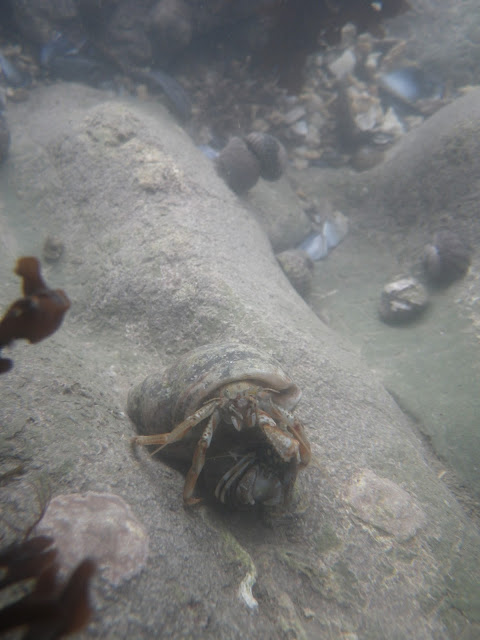Rock pooling destination: Worms Head, Wales, March 2013
(Porcupine Marine Natural History Society Field Trip)
The shore comprises a causeway that stretches out toward
Worms Head, and contains shelving gullies and pools, with occasional boulders.
Mussels and barnacles dominate the shore, with the mussels forming intertidal
beds on sections of the rock and sediment. Pools are characterized by coralline
species of red seaweed and the lower tide swept gullies are covered in Osmudea
spp. and Laminara spp.
Below are photographs of some of the animals you may
encounter in this type of habitat:
Lichens on supralittoral rock. Biotope description: LR.FLR.Lic (Lichens or small green algae on supralittoral and littoral fringe rock).
.JPG) |
| Orange lichen on supralittoral rock |
.JPG) |
| Lichens on supralittoral rock (Lichina pygmaea) |
Barnacles and Mussels community on Rock. Biotope description: LR.HLR.MusB (Mussel and/or barnacle communities)
 |
| Mussel (Mytilus edulis) and barnacle community on eulittoral rock (LR.HLR.MusB) |
 |
| Mussel (Mytilus edulis) beds on eulittoral rock and mixed sediment |
 |
| Barnacle (Balanidae) on a mussel (Mytilus edulis). |
 |
| Barnacles and Mussels (Mytilus edulis) with a dog whelk (Nucella lapillus) |
 |
Barnacles, Mussels (Mytilus edulis), Limpets (Patella vulgata) and Perwinkles (Littorina spp and Melarhaphe neritoides). The Barnacles, Limpets and Periwinkle community on rock is a sub division within the broader barnacles and/or mussel biotope description
|
 |
| Barnacles, Limpets (Patella vulgata), Beadlet anemone (Actinia equina) and Topshells (Gibbula spp.) aggregate in crevices to avoid desiccation when the tide is out |

Barnacles have gained considerable height on this section of the shore
Intertidal pools. Biotope description: LR.FLR.Rkp.Cor.Cor (Coralline crusts and Corallina officinalis in shallow eulittoral rockpools)
 |
| Intertidal pools of the shore are characterized by coralline and Ulva species, whilst the barnacles and mussels (Mytilus edulis) community dominate the areas above the pools |
 |
| Intertidal pools of the shore are characterized by corallinacea crusts, Corallina officinalis and Ulva species |
 |
| The coral weed (Corallina officinalis) |
 |
| The coral weed (Corallina officinalis) in an intertidal pool |
 |
Corallinacea crust
 |
| Corallinacea crust |
|
 |
| A paddle worm (Eulalia viridis) |
 |
| The egg of a paddle worm (Eulalia viridis) |



























.JPG)
.JPG)














































